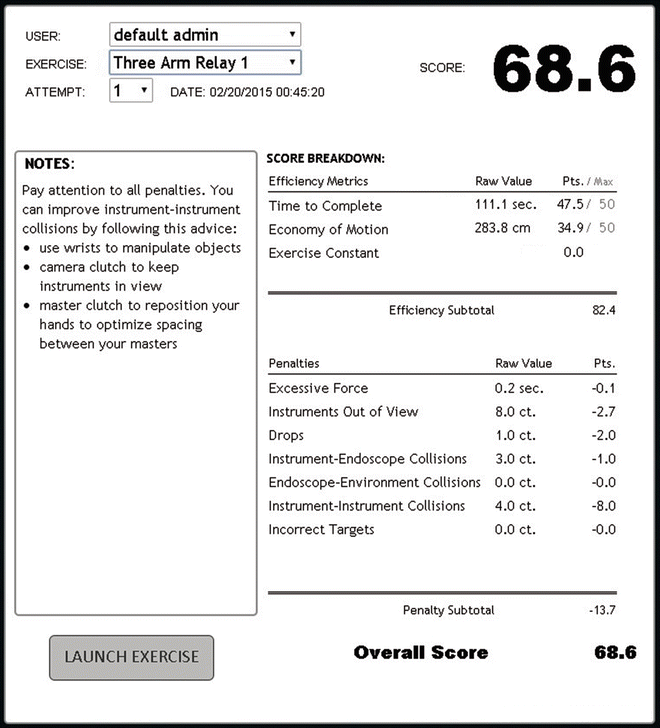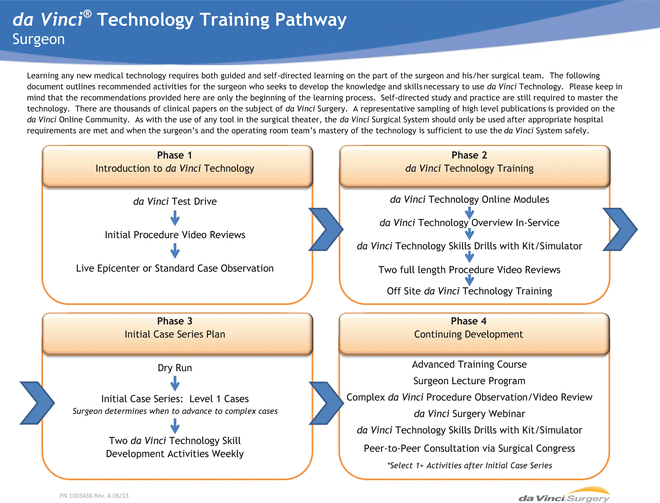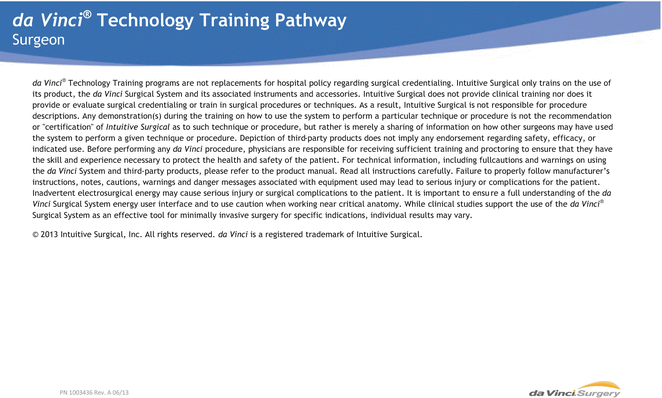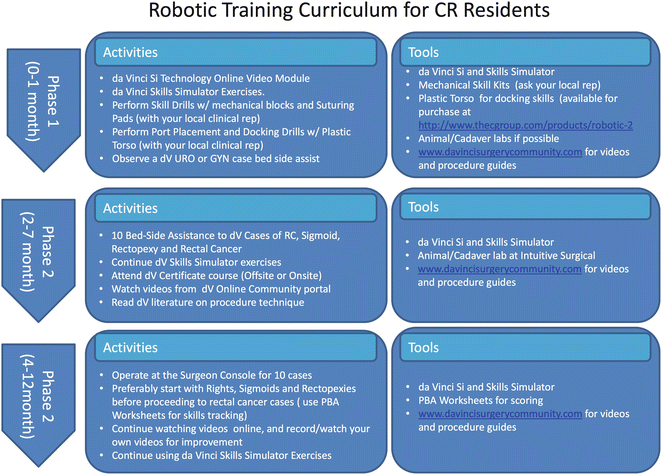Resident
Colorectal resident (Fellow)
Attending
Laparoscopic experience
Hurdle
Advantage
Advantagea
Diversity of cases available
Advantage
Hurdle
Hurdle
Time and income investment
Advantage
Advantage
Hurdle
Interest and acceptance of robotics
Advantage
Advantage
Advantagea
Available mentor
Advantage
Advantagea
Hurdle
Understand anatomy, tissue dynamics and general surgical principles
Hurdle
Advantage
Advantage
Access to patients and training
Hurdle
Advantagea
Advantage
Available robot
Hurdle
Advantagea
Advantagea
Available of skilled trainers or proctors
Hurdle
Advantagea
Hurdle
Sufficient time to learn the technology
Advantage
Hurdle if naïve entering fellowship
Hurdle
Table 21.2
Components of robotics training
Resident | Fellow | Attending | |
|---|---|---|---|
Online modules | X | X | X |
Video review of complete cases | X | X | X |
Dry lab on inanimate models | X | X | X |
Animal lab | +/− | +/− | X |
Cadaver lab | +/− | +/− | X |
Simulation | X | X | X |
Bedside assist | X | X | +/− |
Proctored cases | − | − | X |
Dual console | X | X | +/− |
21.2 Components of Robotic Training
While there are not yet consistent and enforceable regulations to robotics training, there are guidelines published by Intuitive Surgical, Inc., surgical journals, and professional societies. The disadvantages of colorectal surgery has had to date as a specialty in adopting robotic surgery have been a lack of appropriate tools, more variability to surgical procedures and more complex and higher risk operations. But robotic colorectal surgery has the advantage of following robotic urology and gynecology in acceptance and penetration. This allows colorectal surgeons to benefit from the experiences of these other specialties with regard to what works in robotic training.
21.3 Simulator
Training includes time on a simulation console. The digital nature of robotic surgery has lent itself to the development of robust simulation opportunities utilizing the robotic surgical console as they would in the real world. Skill exercises have been identified to facilitate efficient learning of the da Vinci Surgical System and specific skills such as intracorporeal knot tying (Fig. 21.1). These exercises can be performed an unlimited number of times with scores assigned to the trainee with each attempt. This provides immediate feedback, assists with goal setting, and provides an opportunity to compare one trainee with another. There is also the added incentive for the trainee to compete with other users. The opportunity to practice prior to an actual operation helps the trainee as well as the established surgeon. Studies have shown a shortening of the learning curve with the use of the robotic simulator.


Fig. 21.1
Simulator skill assessment. Intuitive Surgical, Inc., Sunnyvale, CA
A systematic review of all available simulators was performed; though there are too few studies to make valid conclusions about which is the best, one group found that all simulators functioned to train surgeons well before performing in vivo robotic resections [4]. A training metric, the Robotic Skills Assessment Score (RSA-Score), was validated in 2013 in order to score practitioners based on skill [5]. Safety, critical error, economy, bimanual dexterity, and time management were the parameters measured.
A multi-institutional “Fundamental Skills of Robotic Surgery” (FSRS) is a simulation curriculum based on the da Vinci robotic system that has been developed and is in use. It has been validated and shows significant improvement in basic robotic skills across specialties [6]. Another group uses deconstructed skills (i.e., docking, positioning, blunt dissection, retraction) in a 23-item training program for their robotic novices [7]. The Hasbro® Game, Operation has been used as a more lighthearted and accessible bridge between simulation and in vivo surgery [8].
21.4 Pathways and Evaluation
Pathways to training create a necessary structure to learning. Intuitive Surgical has published suggested pathways to robotic training for operating surgeons, bedside assist, and the operating room staff (Fig. 21.2). Pathways are also being developed specifically for colorectal residents (Fig. 21.3). The use of pathways is important not only for guidance but also for identifying areas of deficiency that need further improvement. They also establish a framework for evaluation of the trainee. Assessment tools have also been created with which a trainer can appraise and grade the trainee, thus providing necessary feedback (Fig. 21.4).





Fig. 21.2
da Vinci® Training Pathway for Surgeons. Intuitive Surgical, Inc., Sunnyvale, CA

Fig. 21.3
Colorectal robotic training curriculum









